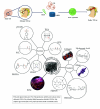Biomimetic Scaffolds for Regeneration of Temporomandibular Joint Disc: A Narrative Review
- PMID: 38962074
- PMCID: PMC11217064
- DOI: 10.30476/dentjods.2023.97625.2024
Biomimetic Scaffolds for Regeneration of Temporomandibular Joint Disc: A Narrative Review
Abstract
Defects and dysfunctions of temporomandibular joint (TMJ) disc are responsible for the majority of TMJ diseases. Current treatments in this matter are usually short-term and only palliative, thus an alternative treatment that offers long-lasting repair is in great demand. In recent years great attempts have been made to prepare an ideal scaffold, which best resembles the native TMJ disc in characteristics such as mechanical, physical and biological properties. This narrative review focuses on developments of the recent ten years in fabrication of scaffolds using decellularized tissues, natural and synthetic biomaterials for regeneration of TMJ disc and compared their properties. PubMed and Google Scholar databases were searched using the following keywords ("TMJ" OR "temporomandibular joint" OR "TMD" OR "temporomandibular disease") AND ("scaffold" OR "hydrogels"). Randomized controlled trials, randomized clinical trials, case-controls, case reports, and animal studies were included. Comments, systematic reviews, meta-analyses, and non-English papers were excluded. The study concluded that hybrid scaffolds have exhibited favorable cell attachment and proliferation. Synthetic scaffolds have shown promise in providing better control over structural properties; however, additional processes are often required to provide biomimetic cell signaling. While there is still much to learn about the ideal scaffold for TMJ disc regeneration, both natural and synthetic scaffolds have shown promise in achieving the functional, structural, biological, and mechanical properties of a native TMJ disc.
Keywords: Decellularized Extracellular Matrix; Hydrogels; Regeneration; Temporomandibular Joint Disc; Tissue Scaffolds.
Copyright: © Journal of Dentistry.
Conflict of interest statement
The authors declare no conflict of interest.
Figures
Similar articles
-
Advances in 3D printing techniques for cartilage regeneration of temporomandibular joint disc and mandibular condyle.Int J Bioprint. 2023 May 25;9(5):761. doi: 10.18063/ijb.761. eCollection 2023. Int J Bioprint. 2023. PMID: 37457936 Free PMC article. Review.
-
Recent Tissue Engineering Advances for the Treatment of Temporomandibular Joint Disorders.Curr Osteoporos Rep. 2016 Dec;14(6):269-279. doi: 10.1007/s11914-016-0327-y. Curr Osteoporos Rep. 2016. PMID: 27704395 Free PMC article. Review.
-
Acellular matrix hydrogel for repair of the temporomandibular joint disc.J Biomed Mater Res B Appl Biomater. 2020 Oct;108(7):2995-3007. doi: 10.1002/jbm.b.34629. Epub 2020 Jun 29. J Biomed Mater Res B Appl Biomater. 2020. PMID: 32598574
-
Three-dimensional, biomimetic electrospun scaffolds reinforced with carbon nanotubes for temporomandibular joint disc regeneration.Acta Biomater. 2022 Jul 15;147:221-234. doi: 10.1016/j.actbio.2022.05.008. Epub 2022 May 10. Acta Biomater. 2022. PMID: 35562008
-
Inductive Remodeling of Extracellular Matrix Scaffolds in the Temporomandibular Joint of Pigs.Tissue Eng Part A. 2022 May;28(9-10):447-457. doi: 10.1089/ten.TEA.2021.0123. Epub 2022 May 2. Tissue Eng Part A. 2022. PMID: 34809494 Free PMC article.
References
-
- Liang J, Yi P, Wang X, Huang F, Luan X, Zhao Z, et al. Acellular matrix hydrogel for repair of the temporomandibular joint disc. J Biomed Mater Res B Appl Biomater. 2020; 108: 2995–3007. - PubMed
-
- Kobayashi E, Nakahara T, Inoue M, Shigeno K, Tanaka A, Nakamura T. Experimental study on in situ tissue engineering of the temporomandibular joint disc using autologous bone marrow and collagen sponge scaffold. J Hard Tissue Biol. 2015; 24: 211–218.
-
- Tuncer A. Kinesiology of the temporomandibular joint. 1th ed. Comparative Kinesiology of the Human Body: Elsevier; 2020. pp. 285–302.
-
- Legemate K, Tarafder S, Jun Y, Lee CH. Engineering Human TMJ Discs with Protein-Releasing 3D-Printed Scaffolds. J Dent Res. 2016; 95: 800–807. - PubMed
Publication types
LinkOut - more resources
Full Text Sources

